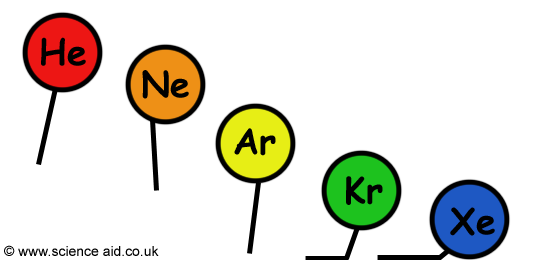Noble gases
Edited by Jamie (ScienceAid Editor), Taylor (ScienceAid Editor), SarMal, Sharingknowledge
The Structure of Noble Gases
Noble gases are in group 0 on the periodic table. This means they have a full outer electron field, making them nonreactive. This also means they are monatomic, they do not join with other elements that are the same but are single and alone. As you move down the table, the density and the boiling point of the gases increase.
Uses of Noble Gases
- 1Probably the most famous noble gas is Helium, (the gas used in balloons). It floats due to the fact it is less dense than air, so rises above it. Helium is completely safe as it is unreactive, however, the densities increase as you go down the group. In the diagram, 5 balloons have been filled with the different noble gases, and then released from the same point. It shows how high the balloons will rise based on their varying densities. Another thing helium can do is make your voice become very high-pitched if breathed in. However, if you were to breathe in a gas that is denser than air, not recommended, the voice would sound deeper in pitch.Helium.Advertisement
- 2Neon is used inside those bright advertising tubes you see in Las Vegas for example. When a current is passed through the gas it glows bright colors.Neon.
- 3All three of these noble gases are used in light bulbs of varying sorts and uses. The reason these gasses are used is that they will not react from the heat produced by the bulb. Otherwise, we would have exploding light bulbs.Argon, Krypton, and Xenon.
Questions and Answers
I'm doing a science project and I just wanted to ask what are the trends and patterns of noble gases?
Please see the new article Noble Gases: Trends and Patterns.
Referencing this Article
If you need to reference this article in your work, you can copy-paste the following depending on your required format:
APA (American Psychological Association)
Noble gases. (2017). In ScienceAid. Retrieved Apr 19, 2024, from https://scienceaid.net/chemistry/inorganic/noblegases.html
MLA (Modern Language Association) "Noble gases." ScienceAid, scienceaid.net/chemistry/inorganic/noblegases.html Accessed 19 Apr 2024.
Chicago / Turabian ScienceAid.net. "Noble gases." Accessed Apr 19, 2024. https://scienceaid.net/chemistry/inorganic/noblegases.html.
If you have problems with any of the steps in this article, please ask a question for more help, or post in the comments section below.
Comments
Article Info
Categories : Inorganic
Recent edits by: SarMal, Taylor (ScienceAid Editor), Jamie (ScienceAid Editor)










